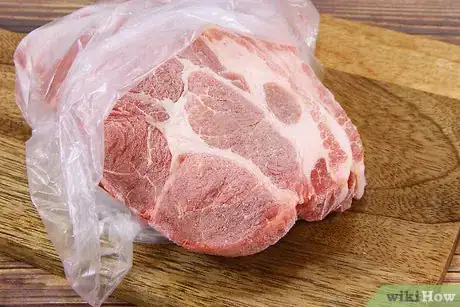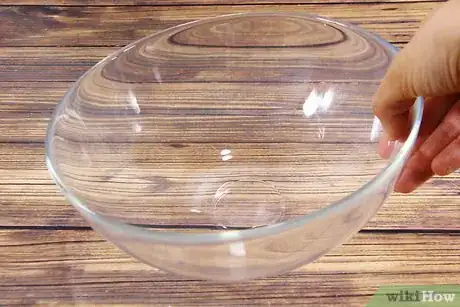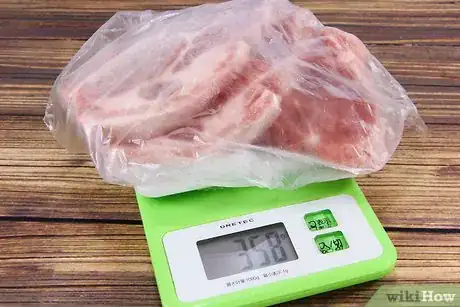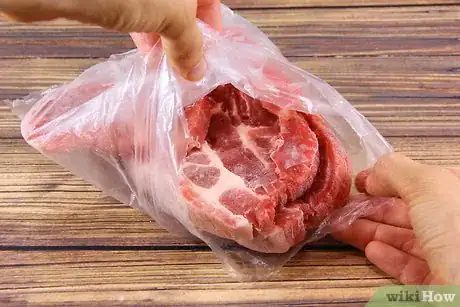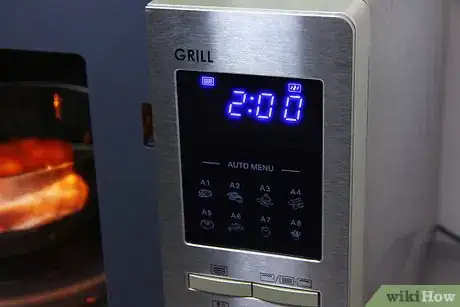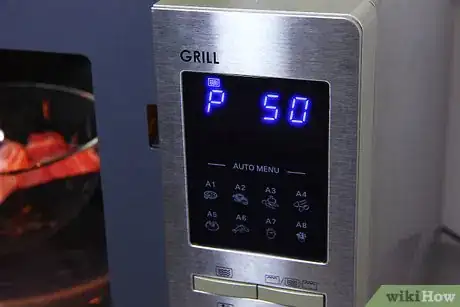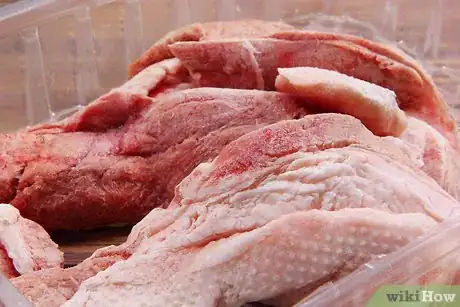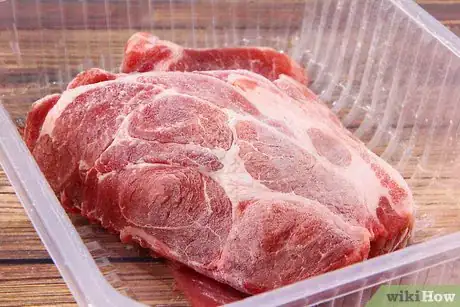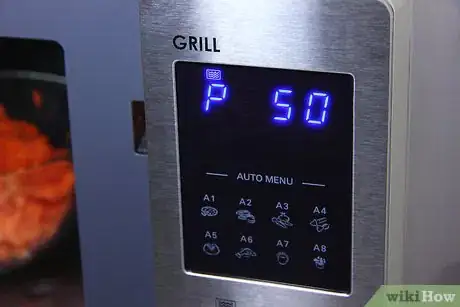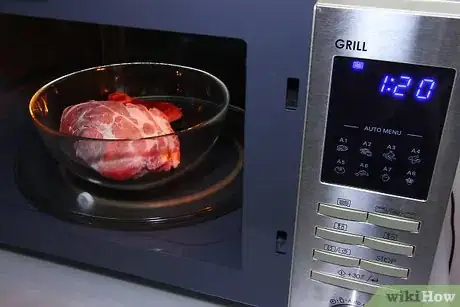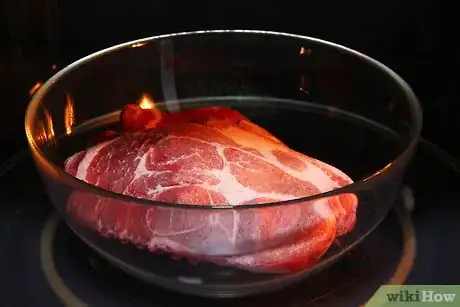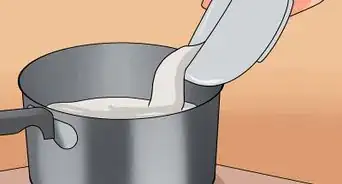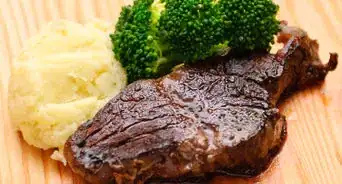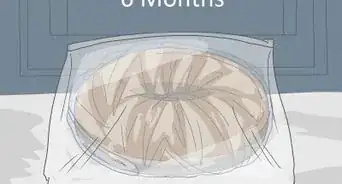This article was co-authored by wikiHow Staff. Our trained team of editors and researchers validate articles for accuracy and comprehensiveness. wikiHow's Content Management Team carefully monitors the work from our editorial staff to ensure that each article is backed by trusted research and meets our high quality standards.
There are 7 references cited in this article, which can be found at the bottom of the page.
This article has been viewed 46,174 times.
Learn more...
If you can't run to the store several times a week to buy meat, keeping it in the freezer can be a great way to keep all that protein fresh — just move that frozen hunk of beef into your fridge 24 hours ahead of time, and it's ready to be cooked. If you're in a hurry to cook that meat now, though, there's a slightly less safe, but still totally effective way. All you need is a microwave, an appropriate container, and a little bit of patience.
Steps
Getting the Meat Ready for the Microwave
-
1Check the meat for signs of spoilage. If your meat has been in the freezer longer than you can remember, you'll probably want to toss it, just to be on the safe side. If not, there are some telltale signs your food has gone bad.[1]
- The meat looks discolored.
- There’s a nasty smell coming from the packaging.
- The package shows signs of freezer burn (ice on the inside).
-
2Find a microwave-safe container. Though it is possible to defrost meat without a container, you'll save yourself a lot of clean up time by using one. Typically, glass bowls are the best, safest containers to use in a microwave.[2]
- If you’re planning to use a plastic container, check out the original packaging to make sure it's safe for microwave use.
- Some other items considered unsafe for the microwave include brown paper bags, aluminum foil, and single-use plastic containers (ex: the kind that take-out food comes in). Basically, if you're not sure, don't use it.
Advertisement -
3Weigh the meat. If the meat is still in its original packaging, it probably has a label that tells you exactly how much it weighs. If it doesn't, you’ll need to weigh it yourself.
- The best tool for weighing meat is a kitchen scale, which gives more specific weights (down to fractions of a lb/kg) than bigger scales.
-
4Remove the meat from its wrapper. Many materials used to package frozen meats should definitely not be microwaved, so be sure to toss everything but the meat itself before you begin cooking.[3]
Microwaving the Meat Properly
-
1Heat a package of boneless chicken breasts for 2 minutes at 50% power. After separating the chicken breasts, flip them over. Then, set the microwave's power to 20%, and heat 1 minute for every 1.5 pounds (0.68 kg) of chicken. About once a minute, flip breasts, while continually removing pieces that are no longer frozen (set those aside for cooking).[4]
- Thawed pieces will feel soft when you poke them with a fork.
-
2Thaw bone-in chicken, first by microwaving at 50% power for 2 minutes. Then, break apart the pieces so they cook more easily and flip them. Reduce power to 30%, and heat 1 minute for every 1.5 pounds (0.68 kg) of chicken. Remove chicken pieces as they thaw — check about every 60 seconds.[5]
-
3Microwave bone-in steaks at 50% power for 2 minutes. Next, separate steaks and turn them over. Reduce microwave power to 30%, and cook 1 minute for each 1 pound (0.45 kg) of steak. Look for thawed steaks once a minute, setting aside any that are ready to be cooked.[6]
-
4Thaw frozen bone-in pork chops, starting with 2 minutes at half power. After that, separate all the pieces and give them a flip. Turn down the power to 30%, and microwave 1 minute per every 1 pound (0.45 kg) of meat. Every 60 seconds, flip over the chops, removing pieces that have defrosted.[7]
-
5Defrost boneless pork chops or steaks for 2 minutes at 40% power. Pull apart all the individual pieces of meat. At 30% power, heat 1 minute for every 0.5 pounds (0.23 kg) of meat. Flip pieces once a minute, while checking for thawed steaks or chops.[8]
-
6Microwave ground beef at 50% power for 2 minutes. Then, break off any thawed sections of meat and resume cooking at 30% power, heating beef 1 minute for every 1.5 pounds (0.68 kg) of meat. Every 30 seconds, scrape off any sections of meat that appear to have defrosted.[9]
- When a section softens and starts to turn brown, you'll know it's thawed.
Practicing Proper Food Safety
-
1Monitor the meat as it defrosts. When it comes to thawing meat in the microwave, it’s super important that you don’t just “set it and forget it.” Meat that hasn't completely defrosted may not cook properly.[10]
- If your microwave plate isn’t rotating automatically, rotate the meat each time you flip it.
-
2Make sure your meat is cooking evenly. At higher temperatures, the edges of frozen food tend to cook more quickly. If you're finding that the middle of your meat isn't thawing as well as the outside, double check your power setting and make sure no cuts of meat are still stuck together.[11]
-
3Cook the meat as soon it’s defrosted. Once food has thawed, harmful bacteria start to grow on it. Heating the meat up to a safe temperature stops that from happening, but only if you cook it right away. [12]
- Use a food thermometer to make sure the meat is fully cooked to a safe temperature.
Warnings
- When uncooked meat warms above the temperature inside a typical refrigerator, it becomes a breeding ground for harmful bacteria. This is why it's so important to cook your meat immediately after thawing.[13]⧼thumbs_response⧽
References
- ↑ https://www.thekitchn.com/7-signs-something-has-gone-bad-in-the-freezer-246505
- ↑ https://www.realsimple.com/food-recipes/tools-products/cookware-bakeware/food-containers-safe-for-microwave
- ↑ https://www.stilltasty.com/articles/view/86
- ↑ https://www.epicurious.com/expert-advice/how-to-thaw-every-food-in-the-microwave-oven-article
- ↑ https://www.epicurious.com/expert-advice/how-to-thaw-every-food-in-the-microwave-oven-article
- ↑ https://www.epicurious.com/expert-advice/how-to-thaw-every-food-in-the-microwave-oven-article
- ↑ https://www.epicurious.com/expert-advice/how-to-thaw-every-food-in-the-microwave-oven-article
- ↑ https://www.epicurious.com/expert-advice/how-to-thaw-every-food-in-the-microwave-oven-article
- ↑ https://www.epicurious.com/expert-advice/how-to-thaw-every-food-in-the-microwave-oven-article
- ↑ https://www.epicurious.com/expert-advice/how-to-defrost-any-meat-article
- ↑ https://www.stilltasty.com/articles/view/9x
- ↑ https://www.fsis.usda.gov/wps/portal/fsis/topics/food-safety-education/get-answers/food-safety-fact-sheets/safe-food-handling/the-big-thaw-safe-defrosting-methods-for-consumers
- ↑ https://www.fsis.usda.gov/wps/portal/fsis/topics/food-safety-education/get-answers/food-safety-fact-sheets/safe-food-handling/the-big-thaw-safe-defrosting-methods-for-consumers
